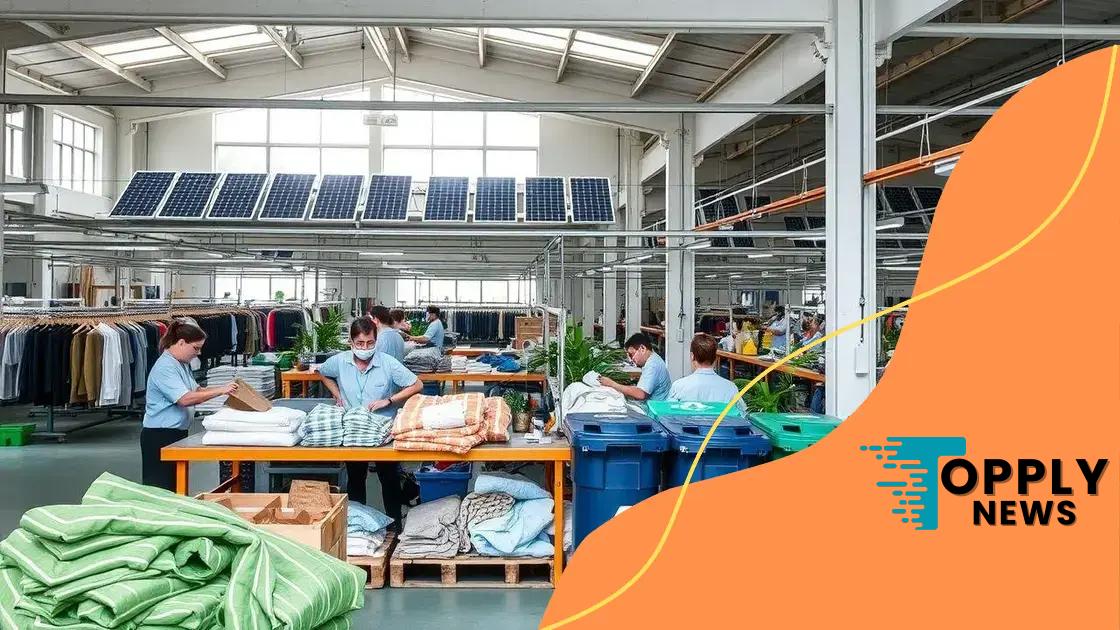How Shein makes high-fashion looks affordable

Shein makes high-fashion looks affordable by leveraging a fast fashion model that prioritizes trendy designs, low prices, and quick response to consumer preferences, despite facing challenges related to sustainability and product quality.
How Shein makes high-fashion looks affordable is a question many fashion lovers consider today. With trends changing rapidly, Shein seems to have cracked the code to bring runway styles to everyday wardrobes. But how do they do it?
The business model behind Shein
The business model behind Shein is both innovative and effective. By utilizing a unique approach, they have managed to offer trendy clothing at affordable prices. This model allows them to respond quickly to changing fashion trends and consumer demands.
Shein’s Fast Fashion Strategy
One of the keys to Shein’s success is its fast fashion strategy. This means they produce clothing that reflects current trends at a rapid pace. Instead of seasonal collections, Shein releases new items daily, keeping their inventory fresh and exciting.
They achieve this through a strong online presence and advanced data analytics. By analyzing social media trends and customer preferences, Shein can quickly pivot and create designs that will resonate with their audience.
Efficient Supply Chain Management
The efficiency of their supply chain is another reason for their success. By working closely with manufacturers, Shein minimizes the time from design to production. This ensures that they can launch new products faster than traditional retailers.
- Limited run manufacturing keeps their offerings unique.
- Focusing on smaller batches reduces waste.
- Fast shipping options improve customer satisfaction.
Additionally, Shein leverages technology for inventory management. This ensures that they can track trends and adjust production based on real-time data. Consumers appreciate this dynamic approach, contributing to Shein’s growing popularity.
Overall, the business model of Shein reflects a deep understanding of consumer behavior and market needs. Their ability to adapt quickly and effectively is a major factor in their rising success within the fashion industry.
How Shein adapts to fashion trends
Shein’s ability to adapt to fashion trends is one of the key factors driving its popularity. By staying connected to the latest styles and consumer preferences, Shein ensures that its products remain relevant and appealing.
Social Media Influence
In today’s fashion world, social media plays a crucial role in shaping trends. Shein actively monitors platforms like Instagram and TikTok to identify emerging styles. This helps them respond rapidly to what customers want, creating an endless cycle of trendy offerings.
This approach allows them to roll out new designs based on viral moments, ensuring that their clothing reflects the latest cultural waves. Customers can expect to see collections that align with seasonal shifts and trending aesthetics.
Collaborations with Influencers
Another way Shein adapts is through collaborations with fashion influencers. These partnerships not only boost visibility but also help validate the brand’s trendy image. Influencers provide real-time feedback and showcase how to wear Shein’s latest items, making the clothes more accessible to a broader audience.
- They select influencers based on their reach and style relevance.
- Collaborations help create exclusive collections that pique interest.
- Influencers often share their try-on hauls and styling tips.
This strategy enhances customer engagement and keeps them excited about new launches. By leveraging influencer marketing, Shein turns fans into brand advocates, broadening their reach and impact.
Ultimately, Shein’s agility in adapting to fashion trends illustrates their commitment to meeting consumer needs. This dedication helps them maintain a strong position in the competitive fashion industry while keeping fashion styles fresh and exciting.
Sustainability practices at Shein

Sustainability practices at Shein have become increasingly important as consumers demand more eco-friendly options. The brand recognizes its responsibility to address environmental concerns while maintaining affordable prices.
Eco-Friendly Materials
One of Shein’s key sustainability efforts is the use of eco-friendly materials. The company is gradually integrating more sustainable fabrics into its collections, like recycled polyester and organic cotton. By doing so, they aim to reduce the environmental impact of their clothing production.
Sourcing these materials not only helps the planet but also appeals to a growing group of environmentally-conscious shoppers. Shein’s commitment to sustainability reflects a broader trend within the fashion industry.
Reducing Waste
Shein has also adopted practices to minimize waste. Their strategy includes producing limited quantities of items, which helps to decrease the amount of unsold stock that ends up in landfills. This fast, limited-production approach allows them to adjust to trends quickly while also being more sustainable.
- Implementing more efficient manufacturing processes.
- Encouraging recycling programs for customers.
- Developing educational content about sustainability.
In addition to waste reduction, Shein emphasizes the importance of sustainable practices in its supply chain. By working closely with manufacturers, they ensure that their production processes adhere to environmental standards.
Ultimately, Shein’s focus on sustainability is a step towards a more responsible fashion future. Their efforts to provide affordable and stylish clothing while addressing eco-friendly concerns resonate with consumers looking for options that align with their values.
Quality vs. affordability in fast fashion
The discussion of quality vs. affordability in fast fashion is central to understanding brands like Shein. While they offer trendy clothing at low prices, questions often arise about the quality of these products.
The Price Point Dilemma
Shein’s pricing strategy makes their offerings enticing. With many items available for under $20, they cater to a broad audience. This affordability often attracts young shoppers looking for on-trend pieces without breaking the bank.
However, lower prices can come with compromises in quality. Many consumers wonder if cheap materials will wear out quickly. This leads to an ongoing debate about whether the savings are worth potential trade-offs in durability.
Perceptions of Quality
Despite concerns, Shein works to improve the perception of quality in their products. They focus on design and style, often drawing on current trends while striving to enhance the overall look of their garments. Customers expect fashionable pieces that feel good to wear.
- Using fabric blends to improve comfort.
- Implementing quality checks on selected items.
- Encouraging customer reviews for feedback on quality.
The balance between maintaining low prices and ensuring acceptable quality remains challenging. Many fashion followers prioritize style, often willing to take risks on cheaper choices. Yet, as awareness of sustainability grows, consumers are increasingly savvy about the quality of their purchases.
Ultimately, as Shein navigates this complex landscape, they must keep both affordability and quality in focus. Meeting consumer expectations in both areas can help solidify their position in the competitive fast fashion market.
Consumer reception and market impact
Consumer reception and market impact play crucial roles in the success of fast fashion brands like Shein. The way customers respond to Shein’s offerings greatly influences the brand’s direction and strategies.
Positive Consumer Feedback
Many consumers appreciate Shein for its vast selection of trendy clothing at appealing prices. Shoppers often find that they can refresh their wardrobes without spending a fortune. This affordability attracts a younger demographic eager to follow fashion trends.
Social media buzz further amplifies this positive reception. Many influencers showcase their Shein finds, leading to increased visibility and sales. Customers enjoy the excitement of receiving new clothes quickly, often sharing their experiences online.
Challenges and Criticisms
Despite the praise, Shein faces criticism regarding sustainability and labor practices. Some consumers express concern about the environmental impact of fast fashion. Issues such as clothing waste and the use of non-eco-friendly materials draw scrutiny from eco-conscious shoppers.
- Concerns about the ethical treatment of workers are prominent.
- Questions arise about the sustainability of their production practices.
- Consumers demand more transparency from brands.
This criticism can affect Shein’s reputation, prompting the brand to explore more sustainable practices. By addressing these concerns, Shein can strengthen its relationship with customers who prioritize ethical consumption.
Overall, Shein’s consumer reception and the resulting market impact highlight the dynamic relationship between shoppers and fast fashion. Understanding feedback allows Shein to adapt and grow in an ever-changing fashion landscape.
FAQ – Questions about Shein’s Business Model and Consumer Impact
What makes Shein popular among shoppers?
Shein’s affordability and trendy clothing attract a diverse range of shoppers, especially younger consumers looking for stylish options at low prices.
How does Shein respond to market trends?
Shein continuously analyzes social media and fashion trends to adapt quickly, releasing new styles that align with current consumer interests.
What are the sustainability practices at Shein?
Shein is working towards sustainability by using eco-friendly materials and minimizing waste, although challenges remain regarding overall practices.
How does fast fashion impact the fashion industry?
Fast fashion brands like Shein disrupt traditional retail by providing rapid updates of trends at low prices, but also raise concerns about ethical practices and sustainability.





